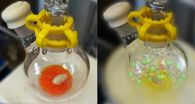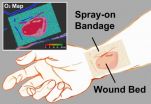(Press-News.org) An international group of researchers led by Dr. Warren E. Piers (University of Calgary) and Dr. Heikki M. Tuononen (University of Jyväskylä) has been able to isolate and characterize an important chemical intermediate whose existence has, so far, only been inferred from indirect experimental evidence.
Chemical reactions rarely go from starting materials to final products in one single step, but instead they progress through a number of intermediates. In many cases the intermediates are not stable enough to be studied by conventional characterization methods, which thwarts efforts to understand reaction mechanisms. In the present case, the research group of Dr. Piers was able to undertake a comprehensive solution and solid-state characterization of an adduct between a Lewis acidic perfluoroarylborane and an electron-rich silane that has been postulated to be an intermediate in the 'frustrated' Lewis-pair hydrosilylation of C=C, C=O and C=N double bonds.
"The results of this paper are important because we now know more about the mechanistic details of a significant chemical reaction," says Dr. Piers, a Tier I Canada Research Chair at the University of Calgary. "It is like travelling along the trans-Canada highway from Victoria to St. John's always blindfolded and finally being able to see the Rockies along the way: a breathtaking moment," he explains.
However, characterizing an important reaction intermediate is only half of the story. Equally important is to understand what factors contribute to its stability and by how much. Here the research group of Academy Research Fellow Dr. Tuononen comes into play with the tools of theoretical modelling.
"Computational work showed that this is a good example of the Goldilocks effect in chemistry: everything needs to be 'just right'," tells Dr. Tuononen. "The calculations not only pinpoint the important contributors to the stability but also enable us to use this information to design similar adducts that are even more stable. This way we can study them experimentally in greater detail for further insight into the underlying chemistry."
INFORMATION:
"Direct observation of a borane–silane complex involved in frustrated Lewis-pair-mediated hydrosilylations" by Adrian Y. Houghton, Juha Hurmalainen, Akseli Mansikkamäki, Warren E. Piers and Heikki M. Tuononen was published online in Nature Chemistry on September 28th, 2014. http://dx.doi.org/10.1038/nchem.2063
Picture: Formation of the reactive borane-silane adduct at -80Celcius is indicated by a color change © Adrian Houghton. Artistic impression of the adduct © Akseli Mansikkamäki
Funding for the work was provided by the Natural Sciences and Engineering Research Council of Canada (W.E.P.) and the Academy of Finland (H.M.T.).
More information:
Heikki M. Tuononen, tel. +358-40-805-3713, heikki.m.tuononen@jyu.fi
Warren E. Piers, tel. +1-403-220-5746, wpiers@ucalgary.ca
Snapshots of chemical reactions: Characterizing an important reactive intermediate
2014-10-01
ELSE PRESS RELEASES FROM THIS DATE:
Omega-3 fatty acids may prevent some forms of depression
2014-10-01
Philadelphia, PA, October 1, 2014 – Patients with increased inflammation, including those receiving cytokines for medical treatment, have a greatly increased risk of depression. For example, a 6-month treatment course of interferon-alpha therapy for chronic hepatitis C virus infection causes depression in approximately 30% of patients.
Omega-3 fatty acids, more commonly known as fish oil, have a long list of health benefits, including lowering the risk of heart disease and reducing triglyceride levels. These nutritional compounds are also known to have anti-depressant ...
Power can corrupt even the honest
2014-10-01
When appointing a new leader, selectors base their choice on several factors and typically look for leaders with desirable characteristics such as honesty and trustworthiness. However once leaders are in power, can we trust them to exercise it in a prosocial manner?
New research published in The Leadership Quarterly looked to discover whether power corrupts leaders. Study author John Antonakis and his colleagues from the University of Lausanne explain, "We looked to examine what Lord Acton said over 100 years ago, that 'Power corrupts and absolute power corrupts absolutely.'"
To ...
Non-traditional donor lungs appear safe for transplant
2014-10-01
Chicago, October 1, 2014 – Patients receiving lungs from donors whose cause of death was asphyxiation or drowning have similar outcomes and long-term survival as patients receiving lungs from traditional donors, according to a study in the October2014 issue of the Annals of Thoracic Surgery.
Key points:
Lungs from donors whose cause of death was asphyxiation or drowning can be safely transplanted into patients with end-stage lung disease.
Patient survival rates were not affected when lungs from cases involving asphyxiation and drowning were used.
The researchers note ...
Strict blood sugar control after heart surgery may not be necessary
2014-10-01
Chicago, October 1, 2014 – Patients undergoing coronary artery bypass grafting (CABG) surgery may not have to follow a strict blood sugar management strategy after surgery, according to a study in the October 2014 issue of the Annals of Thoracic Surgery.
Key points
Liberal management of a patient's blood sugar levels following CABG surgery leads to similar survival and long-term quality of life as achieved through stricter blood sugar management.
The findings applied to all patients, regardless of diabetes status.
The results may encourage hospitals to consider ...
Child mortality falls worldwide, but not fast enough, study finds
2014-10-01
Despite advances, millions of children worldwide still die before their fifth birthday, with complications from preterm birth and pneumonia together killing nearly 2 million young children in 2013, according to a study led by the Johns Hopkins Bloomberg School of Public Health.
Their report, published online Oct. 1 in The Lancet, examines what caused an estimated 6.3 million children under the age of five to die in 2013, one-third fewer than the 9.9 million estimated to have died around the world in 2000. While preterm births and pneumonia were also the top killers in ...
Medical discovery first step on path to new painkillers
2014-10-01
A major medical discovery by scientists at The University of Nottingham could lead to the development of an entirely new type of painkiller.
A drug resulting from the research, published in the journal Neurobiology of Disease, would offer new hope to sufferers of chronic pain conditions such as traumatic nerve injury, for which few effective painkillers are currently available.
The work, led by Dr Lucy Donaldson in the University's School of Life Sciences, in collaboration with David Bates, Professor of Oncology in the University's Cancer Biology Unit, focuses on a ...
'Stealth' nanoparticles could improve cancer vaccines
2014-10-01
Cancer vaccines have recently emerged as a promising approach for killing tumor cells before they spread. But so far, most clinical candidates haven't worked that well. Now, scientists have developed a new way to deliver vaccines that successfully stifled tumor growth when tested in laboratory mice. And the key, they report in the journal ACS Nano, is in the vaccine's unique stealthy nanoparticles.
Hiroshi Shiku, Naozumi Harada and colleagues explain that most cancer vaccine candidates are designed to flag down immune cells, called macrophages and dendritic cells, that ...
'Smart' bandage emits phosphorescent glow for healing below
2014-10-01
WASHINGTON, Oct. 1—Inspired by a desire to help wounded soldiers, an international, multidisciplinary team of researchers led by Assistant Professor Conor L. Evans at the Wellman Center for Photomedicine of Massachusetts General Hospital (MGH) and Harvard Medical School (HMS) has created a paint-on, see-through, "smart" bandage that glows to indicate a wound's tissue oxygenation concentration. Because oxygen plays a critical role in healing, mapping these levels in severe wounds and burns can help to significantly improve the success of surgeries to restore limbs and physical ...
New drug-delivery capsule may replace injections
2014-10-01
CAMBRIDGE, MA -- Given a choice, most patients would prefer to take a drug orally instead of getting an injection. Unfortunately, many drugs, especially those made from large proteins, cannot be given as a pill because they get broken down in the stomach before they can be absorbed.
To help overcome that obstacle, researchers at MIT and Massachusetts General Hospital (MGH) have devised a novel drug capsule coated with tiny needles that can inject drugs directly into the lining of the stomach after the capsule is swallowed. In animal studies, the team found that the capsule ...
Public feels more negative toward drug addicts than mentally ill
2014-10-01
People are significantly more likely to have negative attitudes toward those suffering from drug addiction than those with mental illness, and don't support insurance, housing, and employment policies that benefit those dependent on drugs, new Johns Hopkins Bloomberg School of Public Health research suggests.
A report on the findings, which appears in the October issue of the journal Psychiatric Services, suggests that society seems not to know whether to regard substance abuse as a treatable medical condition akin to diabetes or heart disease, or as a personal failing ...

